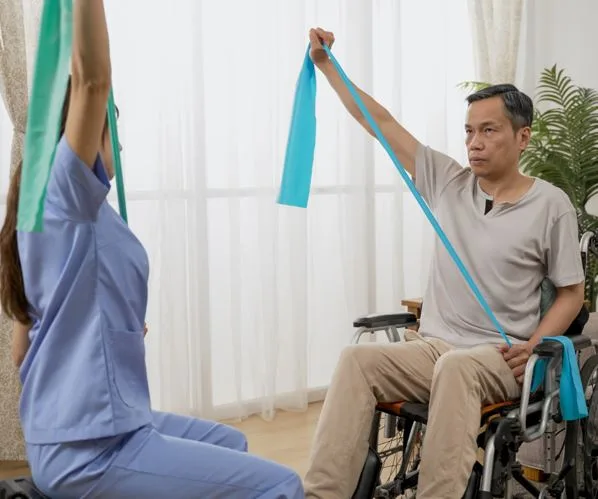The Growing Demand for Mobile Allied Health Services in Australia
Healthcare in Australia is changing. While most of us are used to visiting clinics for physiotherapy, seeing a dietitian in their office, or attending speech therapy sessions at a fixed location, a quiet revolution is taking place across the country. Mobile allied health services are emerging as a vital solution to bridge the gap between those who need care and those who can access it.
Australians living in rural, remote and very remote communities generally have poorer access to healthcare than people in Regional centres and Metropolitan areas, and may need to travel long distances or relocate to attend health services or receive specialised treatment. On average, Australians living in rural and remote areas have shorter lives, higher levels of disease and injury and poorer access to and use of health services, compared with people living in metropolitan areas. This reality has sparked innovative approaches to service delivery, with mobile allied health leading the charge in bringing care directly to patients’ doorsteps.
What Are Mobile Allied Health Services?
Mobile allied health services are models of care that move beyond the traditional clinic setting. Instead of patients traveling to receive care, qualified professionals bring their expertise directly to homes, community centres, schools, and even mobile clinics that travel from town to town.
This approach encompasses a wide range of health professionals including mobile physiotherapists, occupational therapists, speech pathologists, dietitians, podiatrists, and psychologists. These professionals deliver services through various innovative models:
- Home visits by allied health professionals.
- Mobile clinics, such as vans fitted with equipment for therapy or screening.
- Outreach services, where clinicians travel to rural towns or remote communities.
- Hybrid models that mix face-to-face visits with telehealth.
For example, clinics like Sydney Exercise Medicine provide evidence-based exercise programs that can complement mobile allied health services. Their tailored exercise therapies, combined with flexible care delivery, make it easier for patients to recover safely and maintain long-term wellness.
For people receiving NDIS-funded support, it’s also important to understand how service costs are structured. Mobile services often include travel time, which can impact overall pricing. If you’re planning to access mobile allied health through the NDIS, you may want to review the NDIS Price Guidelines 2025: What You Need to Know Before Booking Therapy to ensure you’re across the latest updates before arranging services.
Why Demand Is Growing
Several factors are driving the need for more mobile allied health services across Australia:
1. Ageing population and chronic disease
With an ageing population, more Australians are living with conditions that need regular therapy, rehabilitation, or support. Allied health professionals play a key role in helping older adults stay independent, prevent falls, and manage chronic illness.
2. Rural and remote health inequities
About 28% of Australians live outside metropolitan areas, but access to healthcare is far lower in these regions. Many rural communities do not have resident allied health staff. Mobile outreach is often the only practical way to deliver essential care.
3. Policy and funding support
The Australian Government is preparing a National Allied Health Workforce Strategy to better meet demand and improve access, particularly in rural and remote areas. Funding is also being directed to mobile clinics. For example, the National Indigenous Australians Agency announced $456,000 for a mobile allied health clinic to support remote communities with podiatry and diabetes care.
4. Workforce pressures
Waitlists for allied health services are growing, and there are ongoing shortages of professionals, especially outside cities. Mobile and flexible models can help make better use of the available workforce.
5. Digital health and telehealth
Telehealth expanded rapidly during COVID-19, making it easier for people in rural areas to connect with specialists. However, many therapies still need face-to-face support. Combining telehealth with mobile visits gives patients the best of both worlds.
How Mobile Allied Health Works in Practice
The beauty of mobile allied health lies in its flexibility. Different communities and patient populations require different approaches, leading to several distinct models of service delivery.
Outreach and Visiting Services
In remote areas, fly-in/fly-out (FIFO) arrangements allow specialists to visit communities that might otherwise go months without access to services. A physiotherapist might fly to a remote town once a month, spending several days providing intensive treatment to multiple patients. While this model has limitations in terms of frequency and continuity, it fills critical service gaps where no alternative exists.
Mobile Clinics and Pop-Up Services
Specially equipped vans and trailers bring clinic-quality facilities directly to communities. These mobile units can be fitted with exercise equipment for physiotherapy, assessment tools for occupational therapy, or specialized equipment for hearing assessments. They provide visibility in communities and can establish regular visiting schedules that patients can rely on.
Integrated Community Services
Some of the most successful mobile models integrate allied health professionals into existing community health teams or Aboriginal Community Controlled Health Organisations (ACCHOs). This approach ensures cultural safety, provides continuity of care, and leverages existing community relationships and trust.
Student-Led Initiatives
University programs increasingly include rural placements where students provide services under supervision in underserved areas. This model serves a dual purpose: addressing immediate service gaps while building the future rural health workforce by exposing students to rural practice opportunities.
Hybrid Digital-Physical Models
The most innovative approaches combine in-person home visits with digital follow-up care. A physiotherapist might conduct an initial assessment and treatment in a patient’s home, then provide ongoing exercise programs and progress monitoring through video consultations and smartphone apps.
Benefits of Mobile Allied Health
Mobile services can transform outcomes for patients and communities:
- Improved access and equity: Care is brought to those who can’t travel, including older adults, people with disabilities, and residents in remote regions.
- Real-world therapy: Clinicians see patients in their own environment, tailoring therapy to actual living conditions, which often improves results.
- Cost savings for the system: By preventing hospital visits or detecting issues early, mobile care may reduce overall costs.
- Workforce flexibility: Offering mobile roles can help recruit and retain staff who prefer variety and community-based work.
- Innovation potential: Mobile services integrate well with digital health, remote monitoring, and new technology.
Barriers and Challenges
Despite the clear benefits, mobile allied health faces real challenges that require thoughtful solutions.
- High setup and running costs: Outfitting and maintaining mobile clinics is expensive.
- Staff shortages: Recruiting allied health professionals for rural or mobile roles remains difficult.
- Funding gaps: Current Medicare and NDIS structures don’t always cover travel time or mobile operations.
- Integration with the wider health system: Without strong coordination, mobile services risk being isolated.
- Cultural safety: Services must be co-designed with First Nations and multicultural communities to ensure they are trusted and accepted.
- Evidence gaps: More research is needed to measure long-term outcomes and cost-effectiveness.
Future Directions and Opportunities
Looking ahead, mobile allied health is likely to grow and evolve in several ways:
Hybrid Models Becoming Standard
The integration of mobile visits with telehealth, remote monitoring, and digital health tools is likely to become the new normal rather than the exception. This approach maximizes the benefits of in-person contact while leveraging technology for ongoing support.
Digital Integration
Advances in health technology, including artificial intelligence, remote monitoring devices, and electronic health records, will make mobile services more efficient and effective. Allied health professionals will have access to better tools and information, regardless of location.
Innovative Funding Models
Outcomes-based commissioning, social impact bonds, and public-private partnerships offer new ways to finance mobile services sustainably. These models align funding with results, creating incentives for effective service delivery.
Climate-Conscious Design
Next-generation mobile units are incorporating solar power and other sustainable technologies, reducing operational costs while minimizing environmental impact.
Emergency Response Capabilities
Mobile allied health units can play crucial roles in disaster response, providing essential services in bushfire, flood, or pandemic situations when fixed facilities may be compromised.
Conclusion
Mobile allied health services are not just a temporary solution to current challenges. They represent a fundamental evolution in how we think about healthcare delivery. By bringing services directly to patients, these innovative approaches are breaking down traditional barriers and creating new possibilities for equitable, effective care.
The opportunities are real and significant. Rural communities gain access to services that were previously unavailable. Elderly patients receive care in the comfort and safety of their homes. Health systems become more efficient and responsive to community needs.
However, sustainability challenges around funding, workforce, and integration must be addressed thoughtfully and systematically. The solutions require collaboration between governments, providers, and communities, with a shared commitment to making mobile allied health a cornerstone of Australia’s healthcare future.
With the right support, mobile allied health could reshape healthcare delivery in Australia, ensuring more people get the care they need, no matter where they live.






